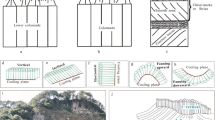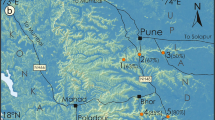Abstract
Columnar jointing in basaltic lava flows on the island of Staffa, NW Scotland, was studied using a combination of field mapping and measurement of column dimensions, sample petrology and measurements of plagioclase crystal size distributions (CSDs) interpreted using theoretical models of cooling. Four different lava flow units were measured, and column ordering was assessed using the hexagonality index and relative standard deviations of column side length, top area and internal angle. Upper and lower colonnades consist of dominantly 5-, 6- and 7-sided columns, with a hexagonality index value very similar to that of Giant’s Causeway and other basaltic columnar jointed localities. CSDs from samples at different heights within one colonnade were used to infer the propagation of the solidus isotherm, which was consistent with a convective cooling mechanism within the colonnade interior. Sample petrology and CSD measurements suggest that entablature can form both by the interaction of propagating joint sets and flooding of the flow surface by water, and the most widely exposed unit on Staffa shows evidence of both mechanisms operating on the same flow. Crystal size distribution measurements can provide a useful tool for field interpretation of lava flow cooling mechanisms.












Similar content being viewed by others
References
Andersen DJ, Lindsley DH, Davidson PM (1993) QUILF: A Pascal program to assess equilibria among Fe-Mg-Ti oxides, pyroxenes, olivine and quartz. Comput Geosci 19:1333–1350
Bailey EB, Anderson EM, Burnett GA, Richey JE, Lee GW, Wright WB, Wilson GV, Thomas HH (1925) The geology of Staffa, Iona and western Mull. Mem Geological Surv Scotland
Beard CN (1959) Quantitative study of columnar jointing. Geol Surv Am Bull 70:379–382
Budkewitsch P, Robin P-Y (1994) Modelling the evolution of columnar joints. J Volcanol Geotherm Res 59:219–239
Burkhard DJM (2002) Kinetics of crystallization: example of micro-crystallization in basalt lava. Contrib Mineral Petrol 142:724–737
Cashman KV (1990) Textural constraints on the kinetics of crystallization of igneous rocks. Rev Mineral 24:259–314
Cashman KV, Marsh BD (1988) Crystal size distribution (CSD) in rocks and the kinetics and dynamics of crystallization II: Makaopuhi lava lake. Contrib Mineral Petrol 99:292–305
Charlier B, Grove TL (2012) Experiments on liquid immiscibility along tholeiitic liquid lines of descent. Contrib Mineral Petrol 164:27–49. doi:10.1007/s00410-012-0723-y
Crain IK (1978) The Monte-Carlo generation of random polygons. Comput Geosci 4:131–141
Degraff JM, Aydin AA (1987) Surface morphology of columnar joints and its significance to mechanics and direction of joint growth. Geol Soc Am Bull 99:605–617
Degraff JM, Aydin AA (1993) Effect of thermal regime on growth increment and spacing of contraction joints in basaltic lava. J Geophys Res 98:6411–6430
Degraff JM, Long PE, Aydin AA (1989) Use of joint-growth directions and rock textures to infer thermal regimes during solidification of basaltic lava flows. J Volcanol Geotherm Res 38:309–324
Ghiorso MS, Sack RO (1995) Chemical mass transfer in magmatic processes. IV. A revised and internally consistent thermodynamic model for the interpolation and extrapolation of liquid–solid equilibria in magmatic systems at elevated temperatures and pressures. Contrib Mineral Petrol 119:197–212
Goehring L, Morris SW (2005) Order and disorder in columnar joints. Europhys Lett 69:739–745
Goehring L, Morris SW (2008) Scaling of columnar joints in basalt. J Geophys Res 113:B10203
Gray NH, Anderson JB, Devine JD, Kwasnik JM (1976) Topological properties of random crack networks. Math Geol 8:617–626
Grossenbacher KA, McDuffie SM (1995) Conductive cooling of lava: columnar joint diameter and stria width as functions of cooling rate and thermal gradient. J Volcanol Geotherm Res 69:95–103
Higgins MD (1994) Numerical modelling of crystal shapes in thin sections: Estimation of crystal habit and true size. Am Mineral 79:113–119
Higgins MD (2000) Measurements of crystal size distributions. Am Mineral 85:1105–1116
Jagla EA (2004) Maturation of crack patterns. Phys Rev E 69:056212
Jakobsen JK, Veksler IV, Tegner C, Brooks CK (2005) Immiscible iron- and silica-rich melts in basalt petrogenesis documented in the Skaergaard intrusion. Geology 33:885–888
Keay J, Keay J (1994) Collins Encyclopaedia of Scotland. Harper Collins Publishers, London
Lachenbruch AH (1962) Mechanics of thermal contraction cracks and ice-wedge polygons in permafrost. Spec Pap Geol Soc Am 70:69pp
Long PE, Wood BJ (1986) Structures, textures and cooling histories of Columbia River basalt flows. Geol Soc Am Bull 97:1144–1155
Lyle P (2000) The eruption environment of multi-tiered columnar basalt lava flows. J Geol Soc Lond 157:715–722
Marsh BD (1998) On the interpretation of crystal size distributions in magmatic systems. J Petrol 39:553–599
Mattson HB, Caricchi L, Almqvist BSG, Caddick MJ, Bosshard SA, Hetenyi G, Hirt AM (2011) Melt migration in basalt columns driven by crystallization-induced pressure gradients. Nat Commun 2:299. doi:10.1038/ncomms1298
Müller G (1998a) Experimental simulation of basalt columns. J Volcanol Geotherm Res 86:93–96
Müller G (1998b) Starch columns: Analog model for basalt columns. J Geophys Res 103:15239–15253
O’Reilly JP (1879) Explanatory notes and discussion on the nature of the prismatic forms of a group of columnar basalts, Giant’s Causeway. Trans Roy Ir Acad 26:641–728
Peck DL, Minakami T (1968) The formation of columnar joints in the upper part of Kilauean lava lakes, Hawaii. Geol Soc Am Bull 79:1151–1116
Peterson TD (1996) A refined technique for measuring crystal size distributions in thin section. Contrib Mineral Petrol 124:395–405
Philpotts AR (1979) Silicate liquid immiscibility in tholeiitic basalts. J Petrol 20:99–118
Press WH, Flannery BP, Teukolsky SA, Vetterling WT (1992) Numerical Recipes Cambridge University Press
Rasband WS (1997–2009) ImageJ. U.S. National Institutes of Health, Bethesda, MD. http://rsb.info.nih.gov/ij. Accessed 28 June 2008
Rieter M, Barroll MW, Minier J, Clarkson G (1987) Thermo-mechanical model for incremental fracturing in lava flows. Tectonophysics 142:241–262
Rivier N, Lissowski A (1982) On the correlation between sizes and shapes of cells in epithelial mosaics. J Phys A Math Gen 15:L143–L148
Roedder E, Weiblen PW (1970) Silicate liquid immiscibility in lunar magmas, evidenced by melt inclusions in lunar rocks. Science 167:641–644
Ryan MP, Sammis CG (1981) The glass transition in basalt. J Geophys Res 86:9519–9535
Saemundsson K (1970) Interglacial lava flows in the lowlands of southern Iceland and the problem of two-tiered columnar jointing. Jokull 20:62–77
Spry A (1962) The origin of columnar jointing, particularly in basalt flows. Aust J Earth Sci 8:191–216
Stormer JC (1983) The effects of recalculation on estimates of temperature and oxygen fugacity from analyses of multi-component iron-titanium oxides. Am Mineral 66:586–594
Swanson DA (1967) Yakima basalt of the Tieton River area, south central Washington. Geol Surv Am Bull 78:1077–1110
Tanemura M, Hasegawa M (1980) Geometrical models of territory. 1. Models for synchronous and asynchronous settlement of territories. J Theor Biol 82:477–496
Thompson RN (1982) Magmatism of the British Tertiary Volcanic Province. Scott J Geol 18:49–107
Thompson RN, Morrison MA, Dickin AP, Gibson IL, Harmon RS (1986) Two contrasting styles of interaction between basic magmas and continental crust in the British Tertiary Volcanic Province. J Geophys Res 91:5985–5997
Tomkeieff SI (1940) The basalt lavas of the Giant’s Causeway district of Northern Ireland. Bull Volcanol 6:89–143
Turcotte DL, Schubert G (2002) Geodynamics. 2nd Ed. Cambridge University Press
Watson EB (1994) Diffusion in volatile-bearing magmas in Carroll, M.R. & Holloway, J.R. (eds) Volatiles in Magmas. Mineral Soc Am Rev Mineral 30:371–411
Weinberger R (1999) Initiation and growth of cracks during desiccation of stratified muddy sediments. J Struct Geol 21:379–386
Wright HMN, Lesti C, Cas RAF, Porreca M, Viramonte JG, Folkes CB, Giordano G (2011) Columnar jointing in vapor-phase-altered, non-welded Cerro Galan Ignimbrite, Paycuqui, Argentina. Bull Volcanol 73:1567–1582
Xu S (1980) Discussion on the morphological charactersistics of two-layer columnar joints in basalt and their forming mechanism. Geol Rev 26:510–515, in Chinese, with English abstract
Acknowledgments
We gratefully acknowledge a grant from the Edinburgh Geological Society which contributed towards fieldwork costs. We thank Chiara Petrone for assistance with electron microprobe analyses, Bob Mehew for helpful discussions and photographs, Thierry Menand for useful discussions about fracturing, and Scottish Natural Heritage for permission to work on the island. MCSH was supported by a Junior Research Fellowship from Trinity College, Cambridge. We are grateful to Marie-Noelle Guilbaud and Hugh Tuffen for the very thorough and detailed reviews that improved the manuscript and to Ben Van Wyk de Vries for the helpful editorial guidance.
Author information
Authors and Affiliations
Corresponding author
Additional information
Editorial responsibility: B. Van Wyk de Vries
Rights and permissions
About this article
Cite this article
Phillips, J.C., Humphreys, M.C.S., Daniels, K.A. et al. The formation of columnar joints produced by cooling in basalt at Staffa, Scotland. Bull Volcanol 75, 715 (2013). https://doi.org/10.1007/s00445-013-0715-4
Received:
Accepted:
Published:
DOI: https://doi.org/10.1007/s00445-013-0715-4




